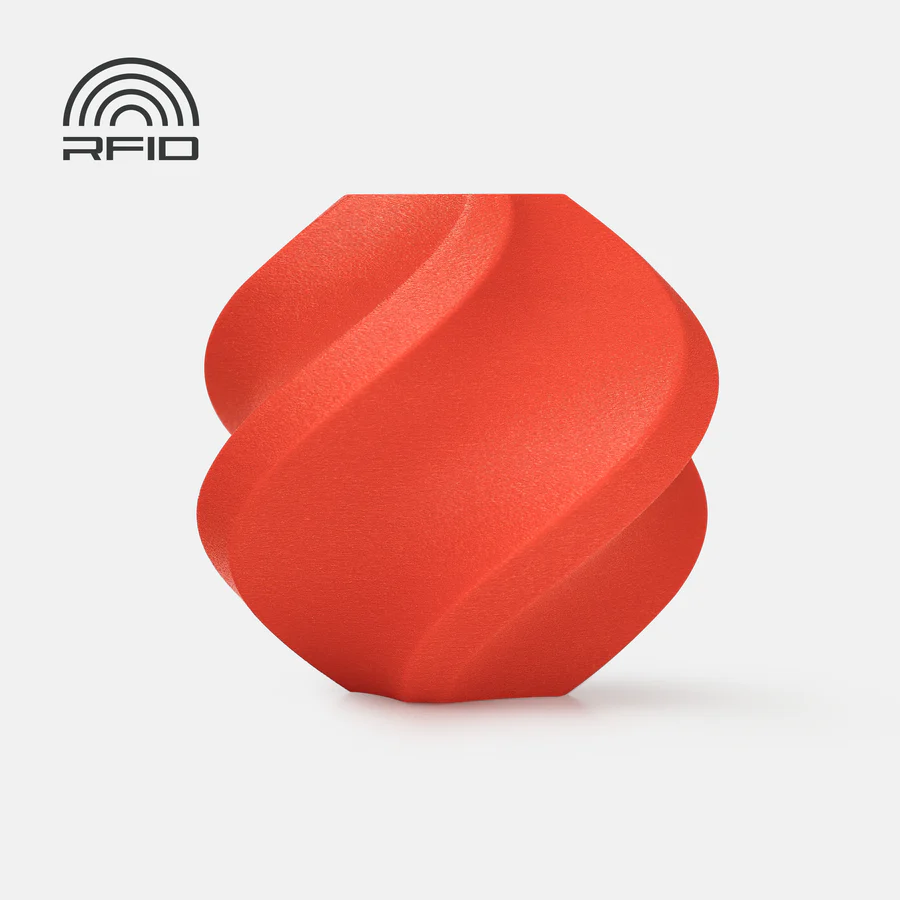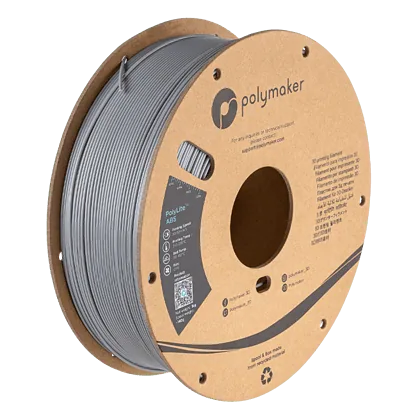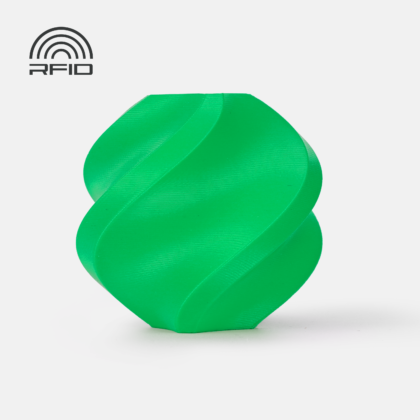ABS + GF – Red – with spool – Bambu Lab
Bambu ABS-GF
Bambu ABS-GF is a glass fibre reinforced ABS filament with improved mechanical and aesthetic properties. Compared to regular ABS, ABS-GF excels in strength, stiffness, temperature resistance and dimensional stability, while being less susceptible to warping and distortion. The glass imparts a smooth matte surface with microscopic shiny dots that blur the lines of the layers. ABS-GF is ideal for both mechanical parts and decorations due to its water resistance, abrasion resistance, durability and vibrant colors.
Increased strength and rigidity
ABS-GF outperforms regular ABS in strength and stiffness, making it ideal for load-bearing and bend-resistant parts.


| Property | ABS | ABS-GF | Improvement (%) |
|---|---|---|---|
| Bending modulus (XY) | 1880 MPa | 2860 MPa | 52.1% |
| Flexural strength (XY) | 64 MPa | 68 MPa | 6.3% |
| Layer strength (Z-bend) | 39 MPa | 46 MPa | 17.9% |
| Heat resistance (HDT at 0.45 MPa) | 87 °C | 99 °C | 13.8% |
Greater dimensional stability
The glass fiber reinforcement gives ABS-GF better dimensional stability than regular ABS, minimizing distortion and warping during printing. This makes it ideal for complex mechanical assemblies or geometric components.

Fine matt finish
The seamless matte finish, combined with almost invisible ply lines, gives ABS-GF a smooth surface, making it ideal for decorative and fine-grained detailing.
Water resistance and durability
With improved water resistance and durability, Bambu ABS-GF is ideal for printing durable production and household items such as mechanical housings, connectors and moulds.
Compatibility with accessories
| Recommended | Not recommended | |
|---|---|---|
| Printing surface | Smooth PEI plate, Textured PEI plate | Cool Plate SuperTack |
| Hotend | Hotend with hardened steel nozzle 0.4 mm / 0.6 mm (recommended) / 0.8 mm | Hotend with stainless steel nozzle (all sizes) |
| Glue | Bambu liquid glue, Glue stick | / |
ABS-GF Hex Code Table
| Colour | Hex code | View |
|---|---|---|
| White | #FFFFFF | |
| Grey | #C6C6C6 | |
| Yellow | #FFE133 | |
| Orange | #F48438 | |
| Red | #E83100 | |
| Green | #61BF36 | |
| Blue | #0C3B95 | |
| Black | #000000 |
Comparison of parameters
| Property | ABS | ABS-GF (with glass fibre) | PA6-GF (glass fibre) |
|---|---|---|---|
| Composition | Acrylonitrile – butadiene – styrene | Acrylonitrile – butadiene – styrene, glass fibres | PA6, glass fibre |
| Compatibility with AMS | YES | YES | YES |
| Drying before use | Recommended | Recommended | Required |
| Print speed | < 300 mm/s | < 180 mm/s | < 130 mm/s |
| Printer type | Enclosed | Enclosed | Enclosed |
| Strength (impact – XY) | 39.3 kJ/m² | 14.5 kJ/m² | 27.2 kJ/m² |
| Flexural strength (XY) | 62 MPa | 68 MPa | 120 MPa |
| Layer strength (bending – Z) | 39 MPa | 46 MPa | 51 MPa |
| Stiffness (bending modulus – XY) | 1880 MPa | 2860 MPa | 3670 MPa |
| Bonding between layers (punch – Z) | 7.4 kJ/m² | 5.3 kJ/m² | 4.1 kJ/m² |
| Heat resistance (HDT, 0.45 MPa) | 87 °C | 99 °C | 182 °C |
| Water absorption at saturation (25°C, 55% RH) | 0.65 | 0.53 | 2.56 |
| Recommended print settings | Physical properties | Mechanical properties | |||
|---|---|---|---|---|---|
| Drying settings (in oven) | 80 °C, 8 h | Density | 1.08 g/cm³ | Tensile strength | 36 ± 3 MPa |
| Printing and storage in humidity | < 20% RH (in a sealed container with moisture absorbent) | Softening point (Vicat) | 103 °C | Elongation at break | 6.3% ± 1.2% |
| Nozzle temperature | 240 – 270 °C | Deviation temperature at heat | 99 °C | Bending module | 2860 ± 130 MPa |
| Bed temperature (with adhesive) | 80 – 100 °C | Melting temperature | 202 °C | Bending strength | 68 ± 4 MPa |
| Print speed | < 180 mm/s | Melt Index | 7.56 ± 1.4 g/10 min | Impact strength | 14.5 ± 1.5 kJ/m² |
Printing tips
– Drying conditions: 80℃ for 8 hours. Dry the filament before printing to achieve higher print quality.
– To minimize distortion, avoid printing models with large sizes and high fill densities. Use enclosed printers and make sure the build plate is properly applied with adhesive to better bond the print before printing. Set a lower print speed and higher heating panel temperature. For more details, please see: Common print quality problems and solutions on WIKI.
– Like ABS, pungent and unpleasant odors can be emitted during printing. Make sure the printer is placed in a well-ventilated area and use enclosed printers.
What’s in the box




















There are no reviews yet.